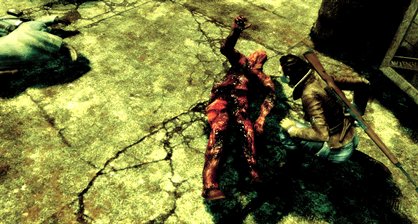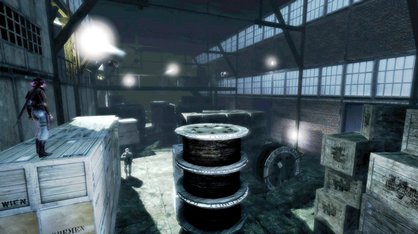Velvet Assassin
She prefers ‘Hit-person’
The lead designer on Velvet Assassin, Sascha Jungnickel, was previously at IO Interactive working on the Hitman series. This will also be a third-person stealth assassination game, but more story-driven and narrowly focused. You play a British Special Operations agent during WWII, carrying out missions based on real events deep within Nazi territory. Jungnickel wearied of the manpower-intensive approach to game design IO had moved towards with Hitman: Blood Money. It took a team of 180 people to make that game. Sascha wanted to work in a smaller team, and focus on mechanics that would work throughout the game rather than coding level-specific ones.

Stealth, in Velvet Assassin, is a binary condition: you’re either hidden or you’re not. A Thief: Deadly Shadows style purple outline indicates if you are. Your weapon-set is simple: a knife, which can kill from behind but is useless otherwise; a Luger, for tight spots; and a sniper rifle for anyone you can’t get near to. But while you can’t take the enemy’s weapons, you can still use some against them. If you’re close to a guard who carries hand grenades, you can remove the pin instead of stabbing him, and he’ll wander oblivious back to his colleagues and kill them all. Later in the game, gas grenades play a role. Your enemies have gas masks, but it takes a moment to don them. That gives you a few seconds to maneuver around them – assuming you’ve already put your own mask on – and that’s often all you need.
The mission we played was set in the streets of German-occupied Warsaw. As Violet Summer, we’ve got to find and infiltrate a prison to deliver cyanide capsules to captured Allied agents, giving them the chance to kill themselves before the Nazi interrogators break them. There’s evidence that this operation actually took place – a grisly thought as you play. The hazy sunset atmosphere is broken by flashes of gunfire in the tenement windows: soldiers probing for hidden refugees the noisy way. Surreally, the streets are littered with furniture: it seems almost like a game conceit, perfect cover for a stealth game, but the Nazis really did rip the flats of Warsaw bare scouring for the few Jewish citizens who refused to flee.

Atmosphere is Velvet Assassin’s main appeal. Jungnickel worked on Blood Money’s superb lighting and filter effects, and here they’re used to evoke a more resonant darkness. Ourappreciation of that was interrupted by a few mechanical limitations, though. The binary stealth system means that if you stumble into a shaft of light you didn’t see, or an area you thought would count as darkness, you’re revealed to nearby guards very suddenly. And strangely for a game that encourages you to circumnavigate your opponents, you can neither jump nor drop down from the ledges and rooftops you climb, except at a few predefined points. If Replay want to prove the virtue of a small team working on a tightly focused game, the story will need to carry Velvet Assassin. For highly flexible mechanics and emergent strategies, Blood Money is a tough act to follow.
Aug 12, 2008
Sign up to the GamesRadar+ Newsletter
Weekly digests, tales from the communities you love, and more


